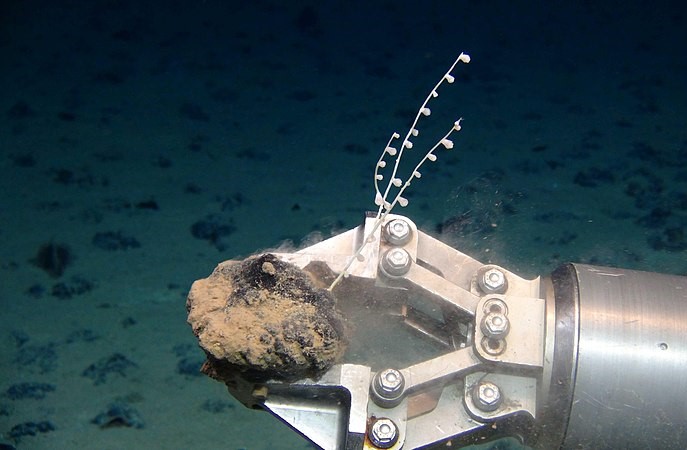 Image credit: GEOMAR'S JPIO Mining Impact Project
Image credit: GEOMAR'S JPIO Mining Impact Project
Drilling Deep on Chinese Deep-Sea Mining
With fossil fuel demand set to peak within the decade, the world is increasing its demand for rare earth elements (REEs) needed to produce batteries, electric vehicles, as well as other renewable and military technology. The world’s pivot to clean energy and increased electrification has profound impacts for national security, primarily regarding strategic competitiveness and China’s outsized role in the critical minerals industry. China already dominates the land-based global supply chains of REEs, as well as most extraction and processing infrastructure, and is steadily expanding its presence in deep-sea mining (DSM)— presenting energy, military, and climate security concerns.
Chinese companies hold 5 of 31 International Seabed Authority contracts that sanction the exploration and development of the ocean floor lying outside of its national boundary. In 2017, Chinese scientists found polymetallic nodules on the Puyuan seamount just south of Taiwan, and in 2020, China ramped up scientific explorations from two artificial islands, the Fiery Cross and Subi Reefs in the South China Sea (SCS). To falsely legitimize its research and development in the SCS, China has intentionally misinterpreted traditional United Nations Convention on the Law of the Sea provisions.
The steadily growing interest in DSM is partly fueled by difficulties in extraction from foreign sources. In 2021, 70% of cobalt was sourced in the Democratic Republic of Congo (DRC), with Chinese companies owning 15 of the country’s 19 cobalt mines. Nearly all the cobalt from these mines is shipped back to China and refined before being sold, taking jobs and profit away from the DRC while giving China near total control of the cobalt supply chain. In fact, a Congolese court recently removed operation of the Tenke Fungurume mine from a Chinese company for cheating on royalty payments. Public backlash and a history of political instability make the DRC a difficult country to invest in, giving China reason to turn toward DSM research and development to maintain its dominance of REEs.
The Chinese Communist Party’s policies regarding its mineral resources are not just economically motivated but also politically motivated. In 2016, President Xi Jinping spoke directly about the deep sea, signaling intent to map and explore the ocean floor. At the national level, mineral exploration is about fulfilling the vision of a strong China at the forefront of technological advancement. China has been investing heavily in DSM technology and has developed the capability to extract minerals from the seabed using remotely operated vehicles, while building up its fleet of DSM vessels, which are equipped with advanced technology such as sonar scanning systems.
This vision is born out in the 14th Five-Year Plan (2021-2025), which outlines technological advancement and a marine economy, along with the minerals needed for their creation, as critical components of China’s future success. The previous, 13th Five-Year Plan also made specific mention of growing the DSM industry, including both its commercialization and the innovation of the deep-sea equipment necessary for mining. In response to these plans, China has developed an international deep sea bed mining law and a set of environmental regulations on pollution and ecosystem damage. However, the environmental legislation raises concerns over its preventative measures, which only regulate actions after the potentially irreparable mining process has been carried out. Little is known about how mining will impact the ocean and its connected ecosystems, but what is clear is that more research is needed to fully understand the impact on ocean ecosystems.
Investment in DSM accomplishes two objectives for China. First, the U.S. and the rest of the world stand to become increasingly dependent on Chinese critical mineral supply, presenting a possible risk to future energy security, technology, and oceans. If there is restricted access to REEs, U.S. manufacturing of solar panels, microchips, and precision guided missiles will be limited, which will inhibit its ability strategically compete with China.
Second, the use of cobalt and other REEs is also critical for defense manufacturing. Indeed, DSM may have direct defense implications, as it is likely that information was shared between the military, commercial, and scientific communities. China has coupled military objectives with its scientific and development projects in its push for influence in the Arctic, and mapping the ocean floor produces bathymetric maps that offer an advantage in submarine warfare and in the planting of sea floor mines.
DSM offers a new area of strategic competition and with-it new security concerns. As excursions into the deep continue to meet increasing demand, the U.S. must be weary of efforts to militarize or unsustainably extract resources from the sea floor.
Image adapted for size from GEOMAR’S JPIO Mining Impact Project under creative commons license 4.0






